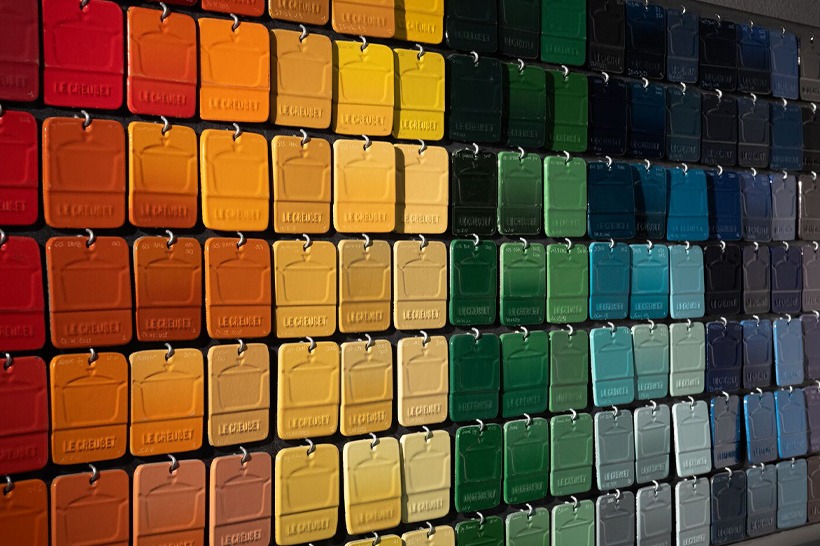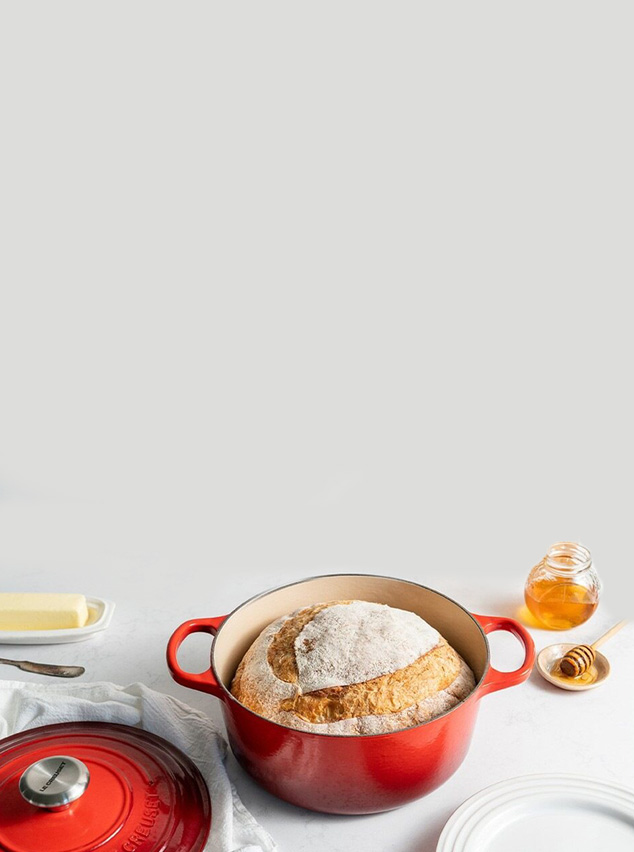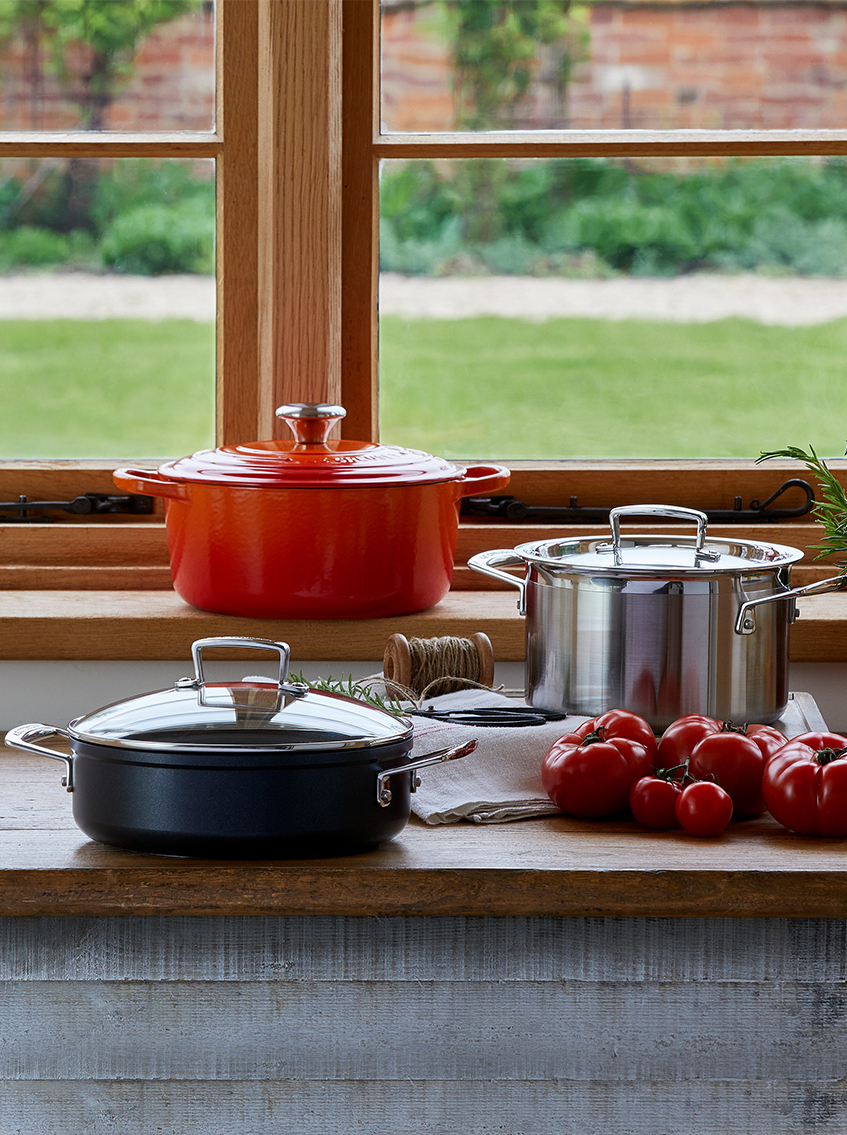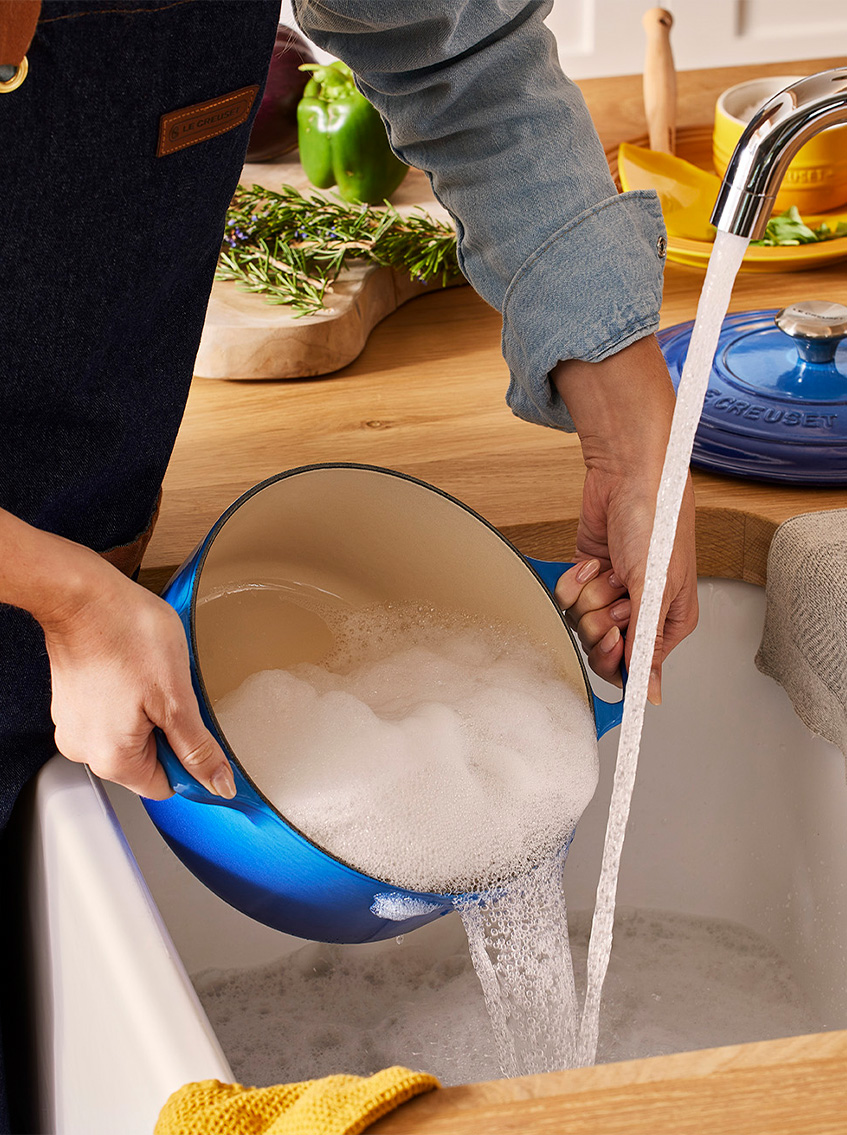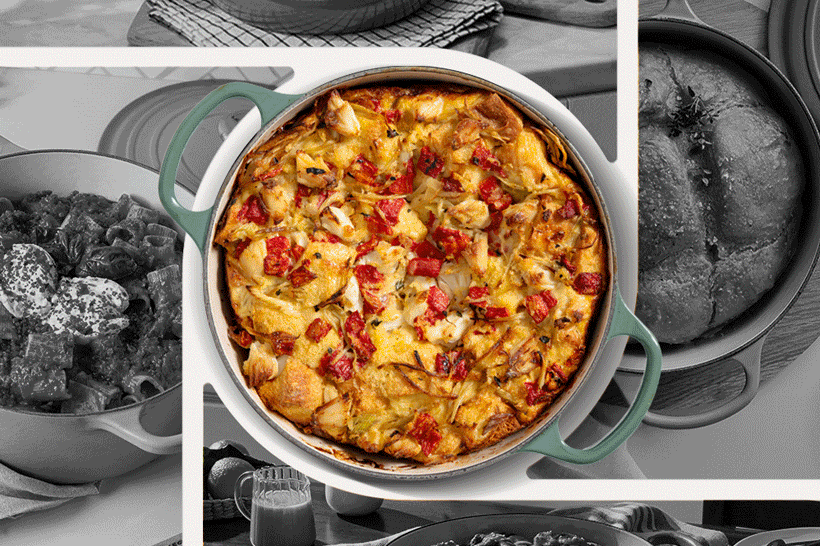Frequently Asked Questions
Where is Le Creuset made?
While Le Creuset enamelled cast iron is manufactured at our
original foundry in France, we do produce different ranges in other parts of the
world. All the facilities, regardless of location, are overseen by Le Creuset
and conform to our high standards.
Is my Le Creuset cast iron compatible with
induction hobs?
Yes, all our cookware (except our stoneware range which should not
be used on the hob top) is suitable for use on an induction hob.
Just remember to keep to a low to medium heat, for durability and
delicious results!
Food is sticking to my cast iron casserole.
What can I do?
It’s important not to overheat your Le Creuset Cast Iron
Casserole – this can cause food to stick. Always cook on a low to medium
heat, whatever heat source you’re using. Make sure you build heat
gradually too.
I’ve dropped my cast iron. Is it covered
by the Lifetime Guarantee?
Unfortunately not. While our cast iron is extremely durable for
all sorts of cooking tasks, the enamel coating is made from glass. This means it
can crack or chip if it’s dropped or knocked.
This type of damage isn’t covered by our Lifetime Guarantee
and we can’t accept dropped items for repair.
The handle on my cast iron saucepan has come
loose. What can I do?
First up, try tightening the handle by gently turning the silver
hanging hook (at the end of the handle) clockwise. If you’re struggling to
tighten the handle, unscrew it to detach it from the pan, then reassemble it.
Just turn the silver hanging hook anti-clockwise to loosen it.
Still need help? Please get in touch with our Customer Service here >
There’s rust on the rim of my cast iron
cookware. Is this normal?
On all cast iron products small areas of rust can sometimes occur
around the rim. If you spot rust, it could be that your cast iron piece
wasn’t thoroughly dried after washing, has been sitting in a damp area
like a draining board or the dishwasher, or possibly the grey enamel base coat
may have chipped.
To remove rust, clean the area with a nylon sponge and washing up
liquid, then thoroughly dry the pan. Once it’s dry, rub a small amount of
sunflower or vegetable oil into the affected area to create a seal and prevent
any rust from reappearing.
How can I get the best out of my Le Creuset
grill or grillit®?
Firstly, it’s important to know how to heat up your grill
properly. Use a medium heat for 3 to 5 minutes, without any oil or other fat.
It’s better to oil and season your food rather than the grill itself. So,
once the grill has built up enough heat, add your oiled and seasoned food and
let it cook undisturbed for a few minutes. When the food is cooked on one side,
it will release easily. Then you can go ahead and turn it to cook the other
side.
Second up, it’s worth knowing that our grills and
grillits®often become even more effective with age and use. That’s
because, over time, the satin black enamel interior can develop a natural
non-stick layer or ‘patina’. This is the result of the ‘baking
in’ of oils and fats from your food. So don’t be alarmed if you
notice this brownish black patina. And don’t be surprised if over time
your grill releases foods even more effortlessly. You may also find
there’s less and less need to add oil or add fat to your food, making your
grill perfect for healthy low or no fat cooking.
Lastly, remember to never pre-grease or ‘burn in’ your
grill – it can damage your piece and its performance.
All our cast iron products are fully sealed with two coats of
premium enamel and don’t need any ‘seasoning’.
How should I look after my Le Creuset pieces?
To keep your favourites in tip top condition, take a look at the
guidance on our Care & Use page.
Can cast iron pieces be cleaned in the
dishwasher?
All our cast iron pieces with an integrated cast iron or phenolic
knob or handle are dishwasher-safe. However, products with a wooden handle are
not dishwasher-safe and should be washed by hand.
But to keep the enamel shining bright use after use, we recommend
taking a moment to clean your cast iron by hand with a dish brush or cleaning
sponge. Remember to dry it thoroughly too.
How heat-resistant are Le Creuset’s cast
iron products?
All cast iron products with a stainless steel knob and metallic
knob are safe for use in a conventional oven up to 260°C. Fully cast iron
products are safe for oven use up to 350°C. Cast iron products are safe for
use under the grill, provided the item is at least 5cm below grill element.
What’s the difference between the light
and dark enamel?
You’ll mainly find our light, bright sand enamel in
casseroles, saucepans and roasters. This cooking surface is very smooth and well
suited to more 'moist' methods of cooking like casseroles, roasting or baking.
Pieces made with this enamel are great for preparing stews and soups, and for
easy roasting. The light surface makes it easy to monitor food as you cook to
avoid burning and makes for a great backdrop when bringing your pots and pans to
the table. It’s especially easy to clean too!
Our darker, black enamel is mainly used on our grills and frying
pans. It’s a little rougher (a more textured enamel) and very hard-wearing
so it won't peel or wear off. Over time, the build-up of frying oils and fats
creates a patina (a protective layer) that reinforces the easy-release
properties, helping food release effortlessly.
Is the enamel scratch-resistant?
Yes, our enamel is scratch-resistant. But it’s always best
to be careful – we recommend you go gentle on your cast iron and use wood,
plastic or silicone cooking utensils. And, when it’s time to clean your
piece, use our specially developed cast iron cleaner.
Are cast iron products rustproof?
Yes, our cast iron cookware is generally rustproof. Areas that
might appear to be uncoated (like lids and pot rims) are actually coated with a
thin enamel primer. Remember to always dry these areas thoroughly after
cleaning.
How do I ‘burn in’ my cast iron
pan?
No, you should never ‘burn in’ your cast iron –
it can damage your pot and its performance.
All our cast iron products are fully sealed with two coats of
premium enamel and don’t need any ‘seasoning’.
What is a patina?
Over time, oils and fats build up to create a brownish black
patina (a protective layer) that gives your piece brilliant easy-release
properties, helping food release effortlessly.
What payment methods can I use?
We accept Visa and Mastercard. Options can vary depending on which
country you’re in, so always take a look at the footer on our website.
If I place an order when will I be charged?
You’ll be charged when we dispatch your order.
How do I apply a discount promo code?
At the checkout. Just go to your basket and, before you complete
your purchase, enter your promo code in the dedicated box. Then click to apply
it. Remember – discounts can’t be applied after checkout.
Can I place my order over the phone?
No, unfortunately not. If you’re having trouble placing an
order online please get in touch with our Customer Services team here >.
Can I make changes to my order, or cancel my
order?
You can only make changes to your order up until you confirm your
order at checkout.
Already completed your purchase, but want to cancel your order?
Please get in touch with our Customer Services team here >.
It is your responsibility to make sure you have read and
understood the Le Creuset conditions of sale before you make a purchase. These
are available on our Terms & Conditions page.
Can I place an order online then collect it
from a Le Creuset store?
No, right now we don’t offer a click and collect service.
What does your order status mean?
| ORDER STATUS | Description |
|---|---|
| Not Paid | Your order has not been placed and processed. Please place your order again and continue the checkout journey until your order is confirmed. |
| In Progress | Your order has been placed and processed. |
| Shipped | Your order has been processed successfully and shipped. |
| Canceled | Your order has been canceled. |
| Not Processed | Your order has failed during payment processing. Please place your order again using another payment method or credit card. |
Can I return an order?
Yes. You’ll discover the full details on our Delivery &
Returns page. Need more help? Please get in touch via our Contact Us page.
Do you deliver to addresses outside of Finland?
No, sorry. We don’t deliver to addresses outside Finland.
But you can use our storefinder or use your local countries website to shop.
Discover more on our Store
Finder.
If I return a product, when will I receive my
refund?
You’ll be refunded no later than 14 days from the day we
receive the goods. We’ll refund you via the same payment option you used
when you placed your order.
Where can I find details of my nearest store?
Simply go to our Store Finder page.
How can I find out when a product will be back
in stock?
If you’re keen to buy a product that’s out of stock on
our site, click the ‘Notify Me When Back In Stock’ button on the
product page and follow the steps.
You can also use our Store Finder page to discover Le Creuset
stores and stockists close to you.
How do I access my account and order history?
Simply log in
to your account. Or get in touch via our Contact Us page if you need a little
more help.
Can I reserve out of stock items?
No, unfortunately not. But by clicking on the ‘Notify Me
When Back In Stock’ button on the item’s product page you’ll
receive a notification when it’s available again.
Can I opt out of receiving Le Creuset
newsletters?
Yes, you can opt out any time by clicking the
‘Unsubscribe’ link at the bottom of the email newsletter.
What are my rights under the Consumer Contracts
Regulation (Distance Selling)?
For full details, please take a look at our Terms & Conditions page.
I’ve forgotten my password. How do I
reset it?
Go to log in,
then click ‘Forgotten password’ and follow the steps. You’ll
receive an email with a link to reset your password. Can’t find the email?
Please check your spam or junk folder. If you’re still having issues, get
in touch via our Contact
Us page.
I’ve got another question. How do I find
an answer?
Send a message using our Contact Us page and we’ll be happy to help.
Secure Payment Gateways






